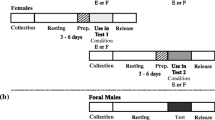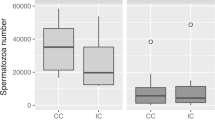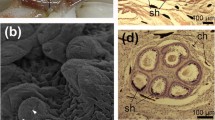Summary
The mechanism by which sperm are transferred from the male's spermatophore to the female's storing cage is described for the rove beetle Aleochara curtula, emphasizing a novel mechanism of sperm displacement by competing males. The cuticular, U-shaped spermatheca is equipped with a valve structure and two sclerotized teeth. The tube of the spermatophore extends into the spermathecal duct through the guidance of the flagellum of the male endophallus. Further elongation of the spermatophore tube, however, occurs only after separation of the pair. A primary tube bursts at its tip after passing through the valve. Within the lumen of the primary tube, a second tube passes through the valve and continues to extend up to the apical bulb of the spermatheca, doubles back on itself and swells to form a balloon filling most of the spermatheca. The balloon of the spermatophore is pierced within the spermatheca by tooth-like structures pressed against the spermatophore through contraction of the spermathecal muscle. The same process of spermatophore growing and swelling is also observed in mated females. Sperm from previous copulations are backflushed through the valve and the spermathecal duct, indicative of last-male sperm predominance.
Similar content being viewed by others
Abbreviations
- ad :
-
adhesive secretion covering the sperm
- sac:
-
am amorphous secretion of the spermatophore
- as :
-
ascending portion of the spermatophore
- ds :
-
descending portion of the spermatophore
- end :
-
parts of the male endophallus
- ext :
-
extended tube
- f :
-
flagellum
- gs :
-
genital segment
- lt :
-
large tooth
- m :
-
muscle of the spermatheca
- nsc :
-
non sclerotized cuticle
- op :
-
opening of the spermathecal gland
- pt :
-
primary tube
- sc :
-
sclerotized cuticle
- sd :
-
spermathecal duct
- se :
-
secretion of the spermathecal gland
- sf :
-
secretion flowing out of the primary tube
- sg :
-
spermathecal gland
- sm :
-
sperm
- smt :
-
small tooth
- sp :
-
spermatheca
- ss :
-
sperm sac
- st :
-
secondary tube
- vm :
-
vaginal muscle
References
Blunck H (1912) Das Geschlechtsleben des Dytiscus marginalis L. 1. Teil: Die Begattung. Z Wiss Zool 102:169–248
Bonhag PF, Wick JR (1953) The functional anatomy of the male and female reproductive systems of the milkweed bug Oncopeltus fasciatus (Dallas) (Heteroptera: Lygaeidae). J Morphol 93:177–284
Chapman RF (1982) The insects, structure and function. Hodder and Stoughton, London Syndney Auckland Toronto, pp 1–919
Diesel R (1990) Sperm competition and reproductive success in the decapod Inachus phalangium (Majidae): a male ghost spider crab that seals off rival's sperm. J Zool Lond 220:213–223
Eberhard WG (1985) Sexual selection and animal genitalia. Harvard University Press, Cambridge London, pp 244
Fiori G (1954) Morfologia addominale, anatomia ed istologia degli apparati genitali di “Pimelia angulata Confalonierii” Grid. (Coleoptera Tenebrionidae) e formazione dello spermatoforo. Boll Entomol Bologna 20:377–422
Fuldner D (1968) Experimentelle Analyse des Orientierungsverhaltens der Eilarve von Aleochara curtula Goeze (Coleoptera: Staphylinidae) am Wirt. Z Vgl Physiol 61:298–354
Gadzama NM, Happ GH (1974) The structure and evacuation of the spermatophore of Tenebrio molitor L. (Coleoptera: Tenebrionidae). Tissue Cell 6:95–108
Gerber GH, Church NS, Rempel JG (1971) The structure, formation, histochemistry, fate and function of the spermatophore of Lytta nutalli Say (Coleoptera: Meloidae). Can J Zool 49:1595–1610
Gregory GE (1965) The formation and fate of the spermatophore in the african migratory locust, Locusta migratoria migratorioides Reiche and Fairmaire. Trans R Entomol Soc London 117:33–66
Hartmann R (1970) Experimentelle und histologische Untersuchungen der Spermatophorenbildung bei der Feldheuschrecke Gomphocerippus rufus L. (Orthoptera: Acrididae). Z Morphol Tiere 68:140–176
Helversen D von, Helversen O von (1991) Pre-mating sperm removal in the bushcricket Metaplastes ornatus Ramme 1931 (Orthoptera, Tettigonoidea, Phaneropteridae). Behav Ecol Sociobiol 28:391–396
Khalifa A (1949) The mechanism of insemination and the mode of action of the spermatophore in Gryllus campestris. Q J Microsc Sci 90:281–292
Klimaszewski J (1984) A revision of the genus Aleochara Gravenhorst of Americannorth of Mexico (Coleoptera: Staphylinidae. Aleocharinae). Mem Entomol Soc Can 129:1–209
Likovsky Z (1974) Gattung Aleochara. In: Freude H, Harde KW, Lohse GA (eds) Die Käfer Mitteleuropas, vol 5. Goecke and Evers, Krefeld, pp 293–304
Mann T (1984) Spermatophores. Zoophysiology, vol 15. Springer, Berlin New York Tokyo, pp 1–217
Miller PL, Miller CA (1981) Field observations on copulatory behaviour in Zygoptera, with an examination of the structure and activity of the male genitalia. Odonatologica 10:201–218
Ono T, Siva-Jothy MT, Kato A (1989) Removal and subsequent ingestion of rival's semen during copulation in a tree cricket. Physiol Entomol 14:195–202
Parker GA (1970) Sperm competition and its evolutionary consequences in the insects. Biol Rev 45:525–567
Peschke K (1978) Funktionsmorphologische Untersuchungen zur Kopulation von Aleochara-curtula Goeze (Coleoptera: Staphylinidae). Zoomorphologie 89:157–184
Peschke K (1986) Development, sex specifity, and site of production of aphrodisiac pheromones in Aleocharac curtula. J Insect Physiol 32:687–693
Peschke K (1987) Male aggression, female mimicry and female choice in the rove beetle, Aleochara curtula (Coleoptera: Staphylinidae). Ethology 75:265–284
Peschke K (1990) Chemical traits in sexual selection of the rove beetle, Aleochara curtula (Coleoptera: Staphylinidae). Entomol Gener 15:127–132
Romeis B (1989) Mikroskopische Technik. Urban and Schwarzenberg, München Wien Baltimore, pp 1–697
Smith RL (1979a) Paternity assurance and altered roles in the mating behaviour of a giant water bug, Abedus herberti (Heteroptera: Belostomatidae). Anim Behav 27:716–725
Smith RL (1979b) Repeated copulation and sperm precedence: paternity assurance for a male brooding water bug. Science 205:1029–1031
Smith RL (ed) (1984) Sperm competition and the evolution of animal mating systems. Academic Press, New York, pp 1–687
Waage JK (1979) Dual function of the damsel fly penis: sperm removal and sperm transfer. Science 203:916–918
Waage JK (1982) Sperm displacement by male Lestes vigilax Hagen (Zygoptera: Lestidae). Odonatologica 11:201–209
Waage JK (1984) Sperm competition and the evolution of odonate mating systems. In: Smith RL (ed) Sperm competition and the evolution of animal mating systems. Academic Press, New York, pp 251–290
Weber H (1974) Grundriß der Insektenkunde. Fischer, Stuttgart, pp 1–640
Yokoi N (1990) The sperm removal behavior of the yellow spotted longicorn beetle Psacothea hilaris (Coleoptera: Cerambycidae). Appl Entomol Zool 25:383–388
Author information
Authors and Affiliations
Rights and permissions
About this article
Cite this article
Gack, C., Peschke, K. Spernathecal morphology, sperm transfer and a novel mechanism of sperm displacement in the rove beetle, Aleochara curtula (Coleoptera, Staphylinidae). Zoomorphology 114, 227–237 (1994). https://doi.org/10.1007/BF00416861
Accepted:
Issue Date:
DOI: https://doi.org/10.1007/BF00416861




